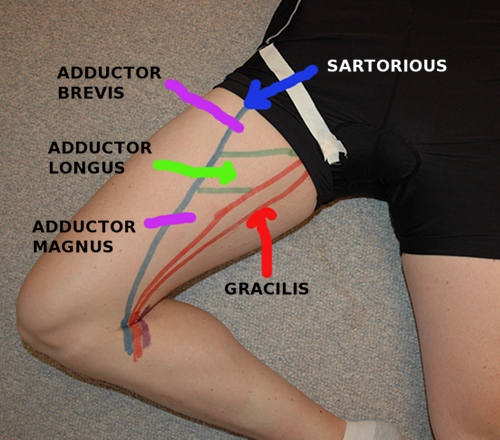In this blog we’ll talk about knee pain, one of the more
common injuries we see, especially as marathon season rolls around. We have previously discussed Iliotibial Band
Friction Syndrome (which creates pain on the outside of the knee), so today we’ll
look at the inside of the knee and specifically the Pes Anserine (P.A.) Tendon.

This tendon, which means ‘goose foot’ in
Latin, is actually the connection of three hip muscles onto the inside of the
knee: the Sartorius, Gracilis, and
Semi-Tendinosis (the inside hamstring.) (In the photo above the tendon is where the blue and brown lines converge at the knee.) Pain
and inflammation of the P.A. Tendon is called Pes Anserine Tendinitis or Bursitis.
Pes Anserine pain is felt distinctly on the inside of the
knee potentially during and after running, jumping, climbing stairs, and other activities. The pain may or may not respond to ice and
NSAID’s, does respond the rest, but can become quite severe if training
continues. This is one of those injuries
that athletes may self-manage for long periods with stretching, foam rolling,
icing, and reducing training but without ever getting it truly solved.
Another structure nearby that can also create inside knee
pain is the medial meniscus. It’s
important to differentiate the two as a medial meniscus tear won’t necessarily
respond to conservative care and can require surgery. Two symptoms that point to a P.A. injury are
medial knee pain after prolonged sitting and also pain in the rear leg with a lunge type motion. Meniscus pain is generally better with rest
and would likely be worse in the front
leg with a lunge. An upper tibial stress
fracture could also cause pain in this area.
An accurate diagnosis is essential as the treatments for these three injuries
are very different.
Note: As always when we write about injuries you’ll see references to the concept of ‘muscle inhibition’, where-by muscles become not just weak but overtly ‘turned-off’ and unable to fire. This concept is often not fully appreciated and yet can be critical to really getting to the root cause of how injuries develop. Inhibition usually stems from issues with the joint(s) that the affected muscle attaches to or near.
There is a great saying about knees, one that we believe: ‘The
knee has the unfortunate circumstance of being located between the hip and the
ankle.’ Outside of overt trauma, most
repetitive knee injuries start with biomechanical issues in the hip joint above
and/or the foot below. The P.A. is no exception;
pain here usually stems from problems in the hip or foot, causing the Sartorius
and/or Gracilis to tighten as they try to over-compensate. We have not seen many cases of P.A. directly
attributable to the Semi-Tendinosis, despite the bad rap that tight hamstrings
receive. The common scenarios we do see
leading to Pes pain are:
·
- Imbalances between the hip flexors and the gluteus maximus causing compensation in the Sartorius. Especially when the hip flexor is overtly inhibited, the Sartorius (being partially a hip flexor itself) will be forced to work excessively.
- Weakness and especially inhibition of the adductor muscle group, causing the Gracilis to compensate. This scenario may or may not have accompanying gluteus medius weakness.
- Foot weakness, especially if accompanied by a toed-out, over-pronating gait, causing the Gracilis (and adductors) to work too hard in helping to control the resulting extra lower leg motion.
In any of these scenarios the compensating muscle(s) become
tight with time, causing the P.A. tendon and sometimes its under-lying bursae
to become inflamed.
As with many injuries, releasing the tight muscles is fairly
straight-forward, while figuring out the under-lying biomechanical cause is
more complicated. Some real-world
examples we’ve seen include:
- Several cases of former soccer players who subsequently took up running. The Sartorius is used more in soccer than most sports (think of trying to hit a hacky-sack with the inside of the foot and you get the idea of its action.) However in each of these cases it wasn’t simply tightness to blame but also accompanying gluteal weakness.
- A prior low back (pelvic) injury causing adductor inhibition and therefore Gracilis tightness.
- A prior low back (lumbar spine) injury causing gluteus maximus and psoas inhibition and then subsequent Sartorius over-compensation.
- An old groin pull (which usually occur in one of the upper adductor muscles,) in which the adhesions (scar tissue) present in the adductors bound up the Gracilis creating P.A. tension.
- Old ankle injuries leaving athletes with residual weakness and a characteristic toed-out gait causing Gracilis compensation.